Among Crete’s countless attractions, Spinalonga Island holds a unique place in Mediterranean history. From its origins as a strategic fortress to its transformation into one of Europe’s last leper colonies, this small island encapsulates centuries of compelling history. While the leper colony closed in 1957, today Spinalonga has transformed into one of Crete’s most visited historic sites, drawing visitors eager to explore its preserved fortress walls and learn about its remarkable past.
From ancient ruins to Ottoman architecture, from poignant human stories to practical visitor information, this complete guide will walk you through everything you need to know about experiencing Spinalonga’s rich heritage and making the most of your visit to this extraordinary island. You’ll be walking in the footsteps of Venetian soldiers, Ottoman merchants, and countless individuals who called this remarkable island home.
Where Is Spinalonga Island Located?
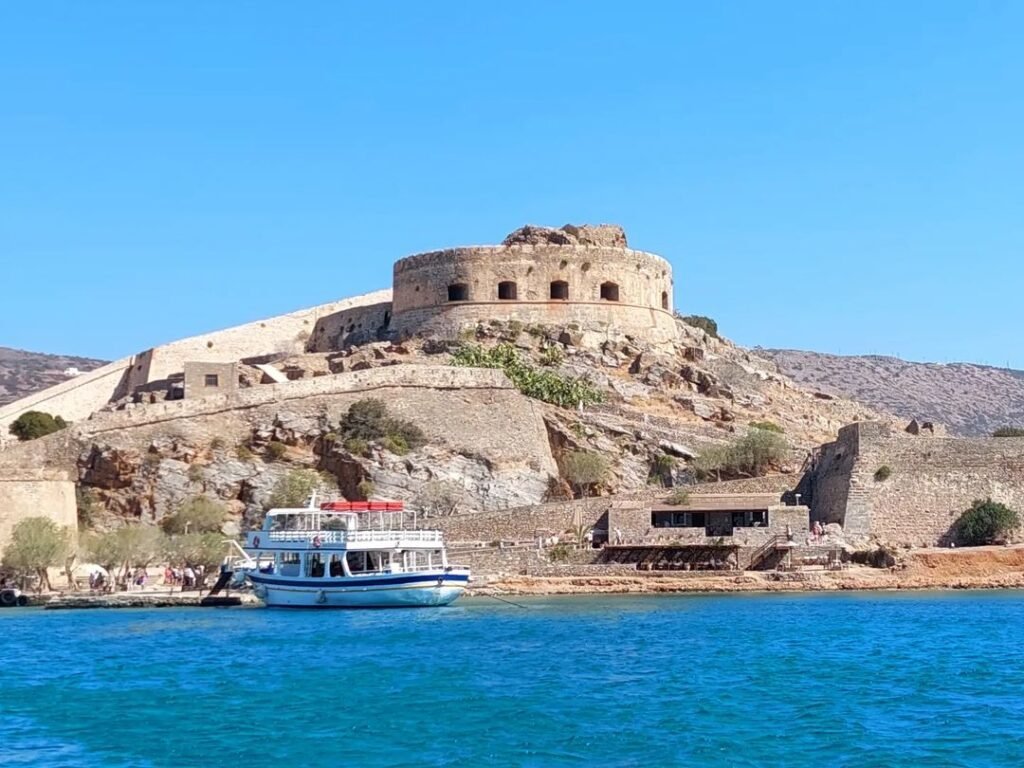
Situated in the pristine Gulf of Elounda in northeastern Crete, Greece, Spinalonga lies within the Lasithi region of Greece’s largest island. The island’s modest dimensions – 170 meters wide and 540 meters long, covering 8.5 hectares – belie its outsized role in Cretan history.
Spinalonga’s location at the mouth of Elounda’s natural harbor made it a crucial defensive point throughout history. This strategic position would shape its destiny from ancient times through the Venetian period and beyond. Today, this same location offers visitors breathtaking views of the Cretan coastline and the surrounding crystal-clear waters of the Mediterranean.

The island’s proximity to three key departure points makes it easily accessible:
- Agios Nikolaos: The largest nearby town
- Elounda: A popular resort area
- Plaka: The closest village to the island
Each of these locations serves as a gateway to exploring this remarkable piece of Cretan heritage, where centuries of history await discovery.
Ancient and Venetian History (Pre-1715)
The story of Spinalonga Island begins not as an island, but as part of the Cretan mainland. In 1526, the Venetians strategically carved out the island from the Elounda peninsula, recognizing its potential as a defensive stronghold. Originally known as Kalydon in ancient Greek times, the outcrop had already proven its worth protecting the harbor of ancient Olous from pirate raids.

The island’s transformation into a formidable fortress began in 1579 under the direction of Venetian engineer Genese Bressani. His architectural genius resulted in one of the Mediterranean’s most impressive defensive systems, featuring:
- 35 cannons positioned strategically around the island
- A complex network of fortification walls
- Seven churches (of which two remain today)
- Military facilities including barracks and storehouses
- An advanced water collection system
The fortress proved so impregnable that even the notorious pirate Barbarossa failed to breach its defenses. Spinalonga maintained its Venetian control until 1715, standing as one of the last Venetian outposts in Crete, impressively holding out for 46 years after the rest of the island fell to Ottoman rule.

Built atop an ancient acropolis, the fortress creates a remarkable layering of history that visitors can still observe today. This strategic location, combined with Bressani’s masterful design, made Spinalonga one of the three most significant sea fortresses in the Mediterranean basin during the Venetian period, alongside Gramvousa and Souda.
The fortress’s architectural legacy remains visible in its ingenious defensive design, where natural rock formations merge seamlessly with built structures. Bressani’s architectural brilliance is particularly evident in the fortress’s asymmetric layout and the unique seaward Michiel demilune, features that set Spinalonga apart from other Mediterranean fortifications.

The Ottoman Period (1715-1903)
After capturing Spinalonga in 1715, the Ottomans transformed the former Venetian fortress into a thriving commercial center. Under Ottoman rule, the island evolved into a bustling community that reached its peak in 1881 with a population of over 1,100 residents. The Ottoman settlement grew to include 200 homes, many built upon Venetian foundations, alongside 25 shops and workshops. A mosque served the Muslim inhabitants, while traditional Turkish baths and a vibrant commercial district along Market Street formed the heart of the community.
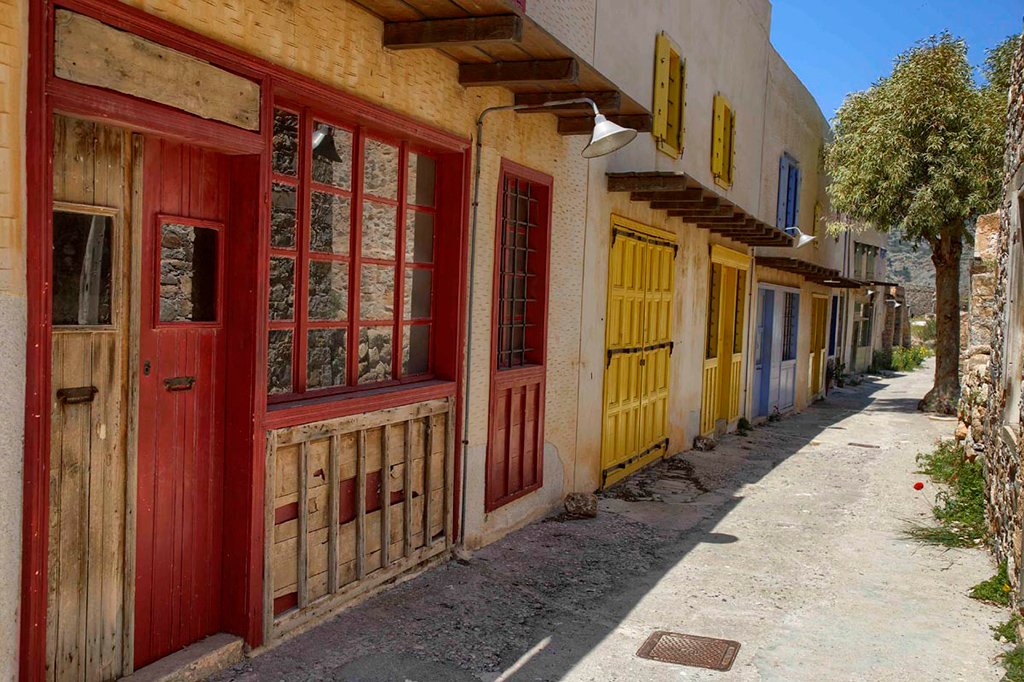
The island’s economy flourished through:
- Fishing
- Agricultural exports (primarily olive oil, carob beans, and almonds)
- Local commerce
- Trade with mainland Crete
During the Cretan uprisings of the 19th century, Spinalonga served as a safe haven for Ottoman families seeking refuge from conflicts. The island maintained its distinct Turkish character until 1903, when the last Ottoman residents departed as plans for the leper colony took shape.
The Ottoman architectural influence created a unique fusion of styles, with builders adding characteristic Turkish features to existing Venetian foundations. This architectural blend is best exemplified along the partially restored Market Street and surviving residential buildings, where traditional Ottoman elements like arched doorways and distinctive window arrangements merge with Venetian stonework.
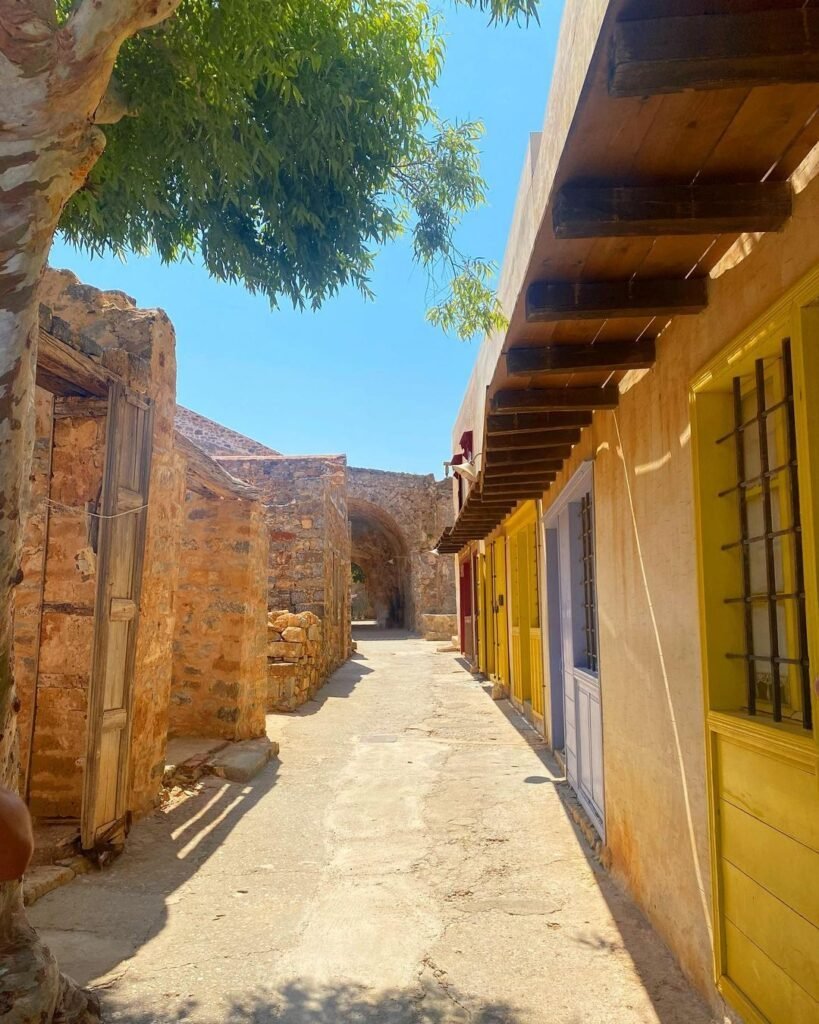
Today, these restored Ottoman-era shops house exhibitions featuring artifacts from this period, offering visitors glimpses into this significant chapter of Spinalonga’s history.
The Leper Colony Years (1903-1957)
The year 1903 marked a pivotal transformation in Spinalonga’s history as the island became one of Europe’s last leper colonies. The first group of 251 patients arrived in October 1904, beginning a new chapter that would last over five decades.

Despite challenging initial conditions, the colony developed into a functioning community. Under the guidance of the Brotherhood of Spinalonga Patients, established in the 1930s, the settlement grew to include essential facilities and services. The island’s population reached its peak in 1933 with 954 inhabitants.

Their story is one of extraordinary courage and community spirit, transforming what could have been a place of despair into a functioning society where people found purpose and dignity despite their circumstances.
The colony developed significant infrastructure:
- A hospital (housed in the converted Ottoman mosque)
- Schools for the children
- Shops and cafes
- A theater and cinema
- A main street with commercial establishments
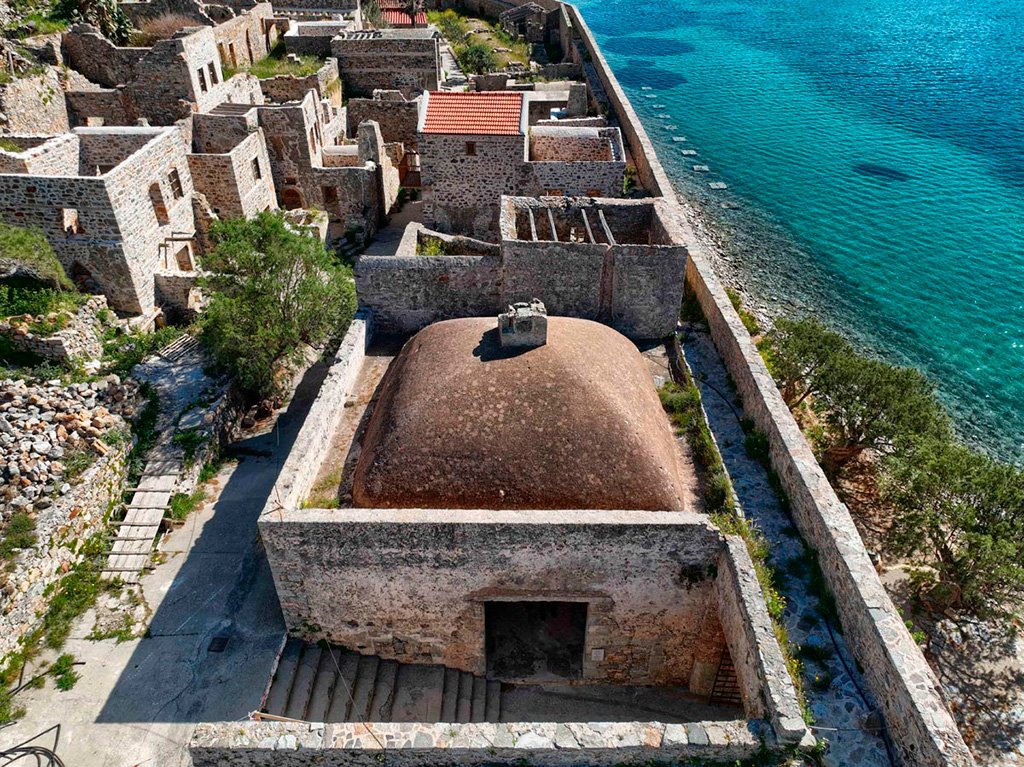
Life in the colony improved significantly during the 1930s when new buildings were constructed and better medical care became available. The community paved the island’s only road, which visitors still use today. Their determination to create a functioning society demonstrated remarkable resilience in the face of isolation and stigma.
The colony’s architectural contributions focused on adapting existing structures while adding new community-centered buildings. The lowlands, once home to Muslim dwellings, now cradle the remnants of the lepers’ first settlements, built from the very stones of their predecessors. The most significant architectural transformation was the conversion of the Ottoman mosque into a hospital, while new construction in the 1930s introduced modern elements that reflected the era’s building styles.

The discovery of effective treatment for leprosy in 1948 eventually led to the colony’s closure in 1957. Today, preserved buildings and a small museum display photographs and personal items, offering visitors insight into this significant period of Spinalonga’s history. The renovated structures house exhibitions featuring everyday objects and medical artifacts from the colony era.
Literary and Media Impact
Spinalonga’s compelling history has captured the imagination of writers and filmmakers, most notably through Victoria Hislop’s bestselling novel “The Island” (2005). The book’s success not only brought international attention to Spinalonga but also helped clear decades of misconceptions surrounding the island’s history. Hislop’s deep connection to Crete – where she maintains a summer home near Agios Nikolaos overlooking what she calls “the most beautiful view on earth” – lends remarkable authenticity to her portrayal of the island’s past.

The story gained even wider recognition through its adaptation into the Greek television series “To Nisi” (The Island). With a budget of €4 million, it became one of Greece’s most expensive and successful TV productions. Filmed entirely on location in Crete, the series featured 83 main characters and over 500 supporting actors, becoming the most-watched show in Greek television history.
The impact of these portrayals is significant: research shows that 22% of visitors come to Spinalonga because of Hislop’s book and the TV series, while 40% of visitors are familiar with the island’s history through these works before their visit. Other notable productions include:
- BBC’s “Island of Ghosts” documentary
- “The Last Leper Colony in Europe”
- “L’Ordre” (1973), featuring interviews with surviving inhabitants

Other significant literary works include “Yannis Remoundakis: Memories from Spinalonga”, offering firsthand accounts of colony life, and the scholarly work “Spinalonga: The Island of the Living Dead”, which provides comprehensive historical analysis.
Today, these literary and media portrayals continue to shape public perception of Spinalonga, helping to preserve its historical significance while attracting visitors from around the world.
UNESCO World Heritage Status
Since 2014, Spinalonga has been on Greece’s Tentative List for UNESCO World Heritage Sites. UNESCO recognizes the island as “a monument to human pain” and “a masterpiece of human ingenuity,” highlighting both its role as a place of isolation and its remarkable military architecture.

The island’s unique features that support its UNESCO nomination include:
- The advanced asymmetric layout of its main fortification
- Its historical significance as a seaward bastion-type fortress
- The preservation of structures from multiple historical periods
Local authorities continue to enhance the site’s preservation and visitor experience through significant infrastructure improvements. A €2.5 million budget has been allocated for projects scheduled through 2024, including:
- Enhanced power and water supply systems
- A new biological waste treatment system
- Improved mooring facilities
- Restoration of buildings from the leper colony era
Should Spinalonga achieve UNESCO World Heritage status, it would become Crete’s second most visited World Heritage Site after the Minoan palace of Knossos.
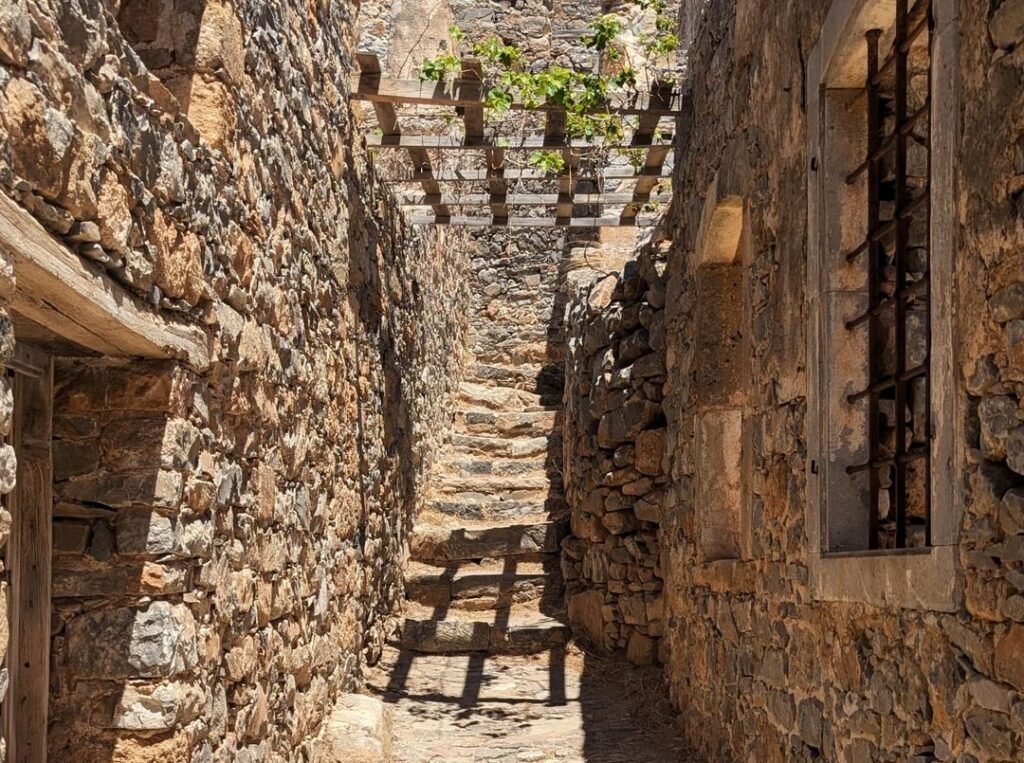
Natural Environment
Flora and Fauna
Despite its rocky terrain, Spinalonga supports a diverse ecosystem adapted to Mediterranean conditions. The island’s vegetation includes prickly pears (introduced during either French or Venetian rule), alongside native fig trees, cypress, and olive trees. Wild herbs like oregano, thyme, and sage add their fragrance to the island’s atmosphere.

The surrounding area serves as a habitat for various bird species, particularly during migration seasons. While the island’s vegetation is relatively sparse, it plays a vital role in supporting local wildlife and maintaining the natural character of this historic site.
Marine Life Around Spinalonga
The crystal-clear waters of Mirabello Bay surrounding Spinalonga offer a vibrant underwater world. The Spinalonga Reef hosts a rich variety of marine life, including:
- Schools of damselfish
- Groupers and wrasses
- Occasional visits from dolphins
- Seasonal appearances of pelagic fish like tuna and mahi-mahi
The waters are also home to protected species such as loggerhead sea turtles. The seabed holds additional historical interest, with ancient pottery shards occasionally visible among the rocks. These waters are part of broader conservation efforts to protect Crete’s marine ecosystem.

Early morning visitors might catch the magical sight of dolphins playing in the crystal-clear waters, while the afternoon sun creates perfect conditions for spotting the colorful marine life beneath the surface.
Practical Visitor Information
Exploring the Island
Enter Spinalonga through Dante’s Gate, the former entrance to the leper colony, and follow the 1.5km perimeter path that encircles the island. The route guides visitors through centuries of history, from Venetian fortifications to Ottoman ruins and leper colony remains.

Each step along the path reveals another layer of the island’s rich history, as fortress walls give way to Ottoman archways, and quiet corners hold memories of the colony years.
A visit to Market Street showcases restored Ottoman-era buildings now housing historical exhibitions. Here you’ll find displays of photographs, artifacts, and personal items from different periods of the island’s history. While most ruined buildings are closed to visitors, the restored structures offer compelling glimpses into Spinalonga’s past.

Facilities and Planning Your Visit
Basic amenities on the island include:
- A small café
- Toilet facilities
- A souvenir shop
- Museum exhibitions in restored buildings
Plan to spend approximately two hours exploring the island. Wear comfortable shoes as the terrain can be uneven and slippery in places. Visitors with mobility challenges can access the peripheral path, though the interior presents more difficulties.

Bring water and sun protection, especially during summer months. Swimming is not permitted around Spinalonga, but nearby beaches offer excellent opportunities for a post-visit swim.
How to Get to Spinalonga
Boats depart regularly from three main locations:
- Plaka: 10-minute journey (closest departure point)
- Elounda: 20-minute journey
- Agios Nikolaos: Longer trips, often including additional stops and panoramic views
During peak season (May to October), boats operate frequently throughout the day. Advance booking is recommended during July and August, and remember that boat tickets are separate from the island entrance fee.
To make the most of your journey:
- Book tickets in advance during peak season to secure your spot
- Choose early morning departures for cooler temperatures and magical light
- Consider larger vessels from Agios Nikolaos for added amenities and spectacular photo opportunities

Best Time to Visit
The shoulder seasons offer the ideal time to explore Spinalonga. Late spring, from May to June, and early autumn, spanning September to October, provide the perfect blend of pleasant weather and manageable crowds. During these periods, boat services run frequently, allowing you to explore this historic gem at your leisure.
These months also bring the added allure of local festivals, including the Chania Film Festival and Heraklion Gastronomy Festival in October. These local festivals add another dimension to your visit, offering a chance to experience modern Cretan culture while exploring its past. The contrast between Spinalonga’s quiet paths and the lively festival atmosphere creates a memorable journey through time.

If visiting during peak summer months (July-August), opt for early morning or late afternoon to avoid intense heat and larger crowds.
Nearby Destinations
Plaka Village
Plaka, the closest village to Spinalonga, offers more than just a departure point for island visits. This authentic Cretan hamlet provides spectacular views of Spinalonga across the water. Known for its excellent seafood tavernas and traditional atmosphere, Plaka gained additional fame as a setting in Victoria Hislop’s “The Island.” Its proximity makes it an ideal base for Spinalonga visits, with the most frequent and shortest boat crossings taking just 10 minutes.
Elounda
Located 12 km from Spinalonga, Elounda has transformed from a fishing village into a luxurious resort destination while maintaining its authentic charm. The town’s picturesque harbor, dotted with traditional fishing boats, provides a stunning backdrop to the numerous high-end hotels that line the coast. Visitors can enjoy fresh seafood at local tavernas while taking in spectacular sea views, or spend time relaxing on beautiful beaches with crystal-clear waters. As a main departure point for Spinalonga boats, Elounda combines convenient access with excellent accommodation options.
Agios Nikolaos
Agios Nikolaos, situated 27 kilometers from Spinalonga, serves as the region’s vibrant cultural hub. The town is famous for its Lake Voulismeni, a deep lake connected to the sea, around which bustling cafes and restaurants create a lively atmosphere. Culture enthusiasts will appreciate the Archaeological Museum showcasing Eastern Crete’s history, while the town’s shopping district offers modern amenities and local crafts. The town provides an excellent base for exploring both Spinalonga and the broader Lasithi region, offering a perfect blend of modern convenience and traditional Cretan character.
Legends and Local Stories
While Spinalonga isn’t directly linked to major Greek mythology, the island has developed its own rich tapestry of local tales and reported supernatural experiences. Some locals suggest it was once a sacred site for ancient Cretans, possibly dedicated to minor deities or nymphs.

The island’s history as a place of isolation has given rise to numerous accounts of unexplained phenomena, particularly around the old hospital and cemetery areas. Visitors sometimes report hearing echoes of the past in the abandoned buildings, while the term “grave of the living” – once used to describe the leper colony – has contributed to the island’s mysterious atmosphere.
Conservation and Future Plans
Spinalonga is undergoing significant transformation through a comprehensive €2.5 million development plan scheduled for completion by 2024. This ambitious project balances preservation with improved visitor experience through several key initiatives.

The Ministry of Culture and Sports is overseeing the restoration of significant buildings from the leper colony era, including the factory, dormitories, and hospital building. These spaces will be transformed into exhibition areas while maintaining their historical integrity. The focus is on preserving the island’s archaeological heritage while creating engaging spaces for visitors to connect with its past.
These developments aim to support Spinalonga’s UNESCO World Heritage bid while ensuring the island can sustainably manage its growing visitor numbers. The challenge lies in preserving the island’s powerful historical testimony while making it accessible to future generations.

Conclusion
Spinalonga stands as more than just another historical site in Crete’s rich landscape. Its remarkable journey from military fortress to Ottoman settlement to leper colony offers visitors a unique window into different chapters of Mediterranean history. The island’s well-preserved structures and carefully curated exhibitions tell powerful stories of human resilience, while ongoing conservation efforts ensure these stories will continue to be told for generations to come.
Whether you’re a history enthusiast, cultural explorer, or simply seeking to understand this remarkable corner of Crete, Spinalonga offers an unforgettable experience. As you catch the boat back to the mainland, you’ll carry with you not just photographs, but a deeper appreciation for this island that has witnessed centuries of human triumph and tragedy. In an age of mass tourism, Spinalonga remains a place of profound historical significance and quiet reflection.
Further reading:
Spinalonga Island Entrance Fee More Than Doubles for 2025: What Visitors Need to Know
From Lancashire to Spinalonga: Meet Juliet Carolan, Author of ‘Footsteps of Fate’


Hello Bella.
When I made my first trips to Crete in 2008 and 2009 I was still living in England and knew nothing about the Ottoman Empire. Where I live now (Bulgaria) there’s evidence of Ottoman history and culture all around me so it’s impossible not to develop an interest in it. Consequently, I now have a greater desire to visit Spinalonga, though not solely for the Ottoman connection. The information in your blog entry makes it an even more desirable destination, so thank you for that.
In recent weeks I’ve read a few of the articles you have written. Your blog is an absolute goldmine of information. You have a new fan, so keep up the good work.
As Bulgarians say… Желая ти всичко най-добро! … I wish you all the best.
Turlough (though my real name’s Terence, or Terry).
Hi Terry (or do you still prefer Turlough?),
Thank you so much for your kind comments—it truly means a lot to me. I only started the Facebook page in June 2024, and the website was launched on October 1st, so it’s still very much a baby. I’m pouring my heart and soul into this project, and it makes me so happy to know that my passion for Crete is shining through in the content I prepare for my weekly newsletters, articles, and social media. Your feedback and support genuinely inspire me to keep going.
I visited Bulgaria for two days back in 2023 and stayed with an acquaintance in Gabrovo. I was completely blown away by all the natural beauty—it was nothing like I expected. I’ve been meaning to return, but every time I plan a trip, I somehow end up booking another flight to Crete instead! LOL!
Με εκτίμηση (Me ektímisi) – With appreciation,
Bella
Hello Bella.
I’m amazed! I hadn’t realised that your site was so new. You’ve done a tremendous amount of work on it since the summer and it’s clear that your passion for Crete really does shine through. I take my hat off to you.
I’m pleased you’ve been to Bulgaria. Not many people come here as it’s often considered to be Europe’s dodgy forgotten corner. Nobody ever expects it to be as beautiful as it is, myself included. I came here for the first time by accident in 2015 when another holiday was cancelled at the last minute. I fell in love with it immediately. I live in Veliko Tarnovo, the medieval capital about 40 kms north east of Gabrovo (a city I know well).
A small problem I have now is when asked how Cretan cheese, honey, rakia, etc compare to what I have at home I have to be quite tactful because really ours is just as good but significantly cheaper (but don’t put that on your website). A lot of events from so-called ‘Greek’ mythology took place in locations that are now modern Bulgarian territory too. I’m a long way from Crete but only a four hour drive from the Makaza crossing on the border with Greece.
I still love visiting other places though. I’ve got family commitments in England in March but my next real trip is to Crete for three weeks next June. I can’t wait.
Лека вечер – lekka vecher – have a good evening.
Тери – Terry
Hello Terry,
Thank you once again for your incredibly kind words—it truly means a lot to me. I wasn’t expecting Bulgaria to be as lush and green as it is, so my short visit in 2023 was such a pleasant surprise. Gabrovo and the surrounding areas were simply beautiful, and I had the privilege of trying some homemade feta during my stay—it was fantastic! I also tasted Bulgarian pink tomatoes, and honestly, I still dream about their incredible flavor.
You might be right about the difference in salaries contributing to the lower prices in Bulgaria compared to Greece. It’s an interesting perspective and definitely makes sense. Of course, both countries have their unique charm and culinary treasures, and I imagine you have the best of both worlds living so close to the Greek border.
Your trip to Crete in June sounds wonderful—I’m already excited for you! I’d love to see some pictures if you feel like sharing them. Perhaps they might even inspire your next poem. Crete has a way of bringing out creativity, doesn’t it?
Με εκτίμηση (Me ektímisi) – With appreciation,
Bella